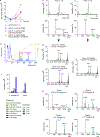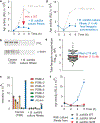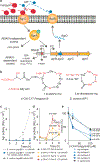Pathogen elimination by probiotic Bacillus via signalling interference
- PMID: 30305736
- PMCID: PMC6202238
- DOI: 10.1038/s41586-018-0616-y
Pathogen elimination by probiotic Bacillus via signalling interference
Abstract
Probiotic nutrition is frequently claimed to improve human health. In particular, live probiotic bacteria obtained with food are thought to reduce intestinal colonization by pathogens, and thus to reduce susceptibility to infection. However, the mechanisms that underlie these effects remain poorly understood. Here we report that the consumption of probiotic Bacillus bacteria comprehensively abolished colonization by the dangerous pathogen Staphylococcus aureus in a rural Thai population. We show that a widespread class of Bacillus lipopeptides, the fengycins, eliminates S. aureus by inhibiting S. aureus quorum sensing-a process through which bacteria respond to their population density by altering gene regulation. Our study presents a detailed molecular mechanism that underlines the importance of probiotic nutrition in reducing infectious disease. We also provide evidence that supports the biological significance of probiotic bacterial interference in humans, and show that such interference can be achieved by blocking a pathogen's signalling system. Furthermore, our findings suggest a probiotic-based method for S. aureus decolonization and new ways to fight S. aureus infections.
Conflict of interest statement
The authors declare that there are no conflicts of interest.
Figures










Comment in
-
Silencing Staphylococcus aureus with probiotics.Nat Rev Microbiol. 2018 Dec;16(12):715. doi: 10.1038/s41579-018-0111-3. Nat Rev Microbiol. 2018. PMID: 30327575 No abstract available.
-
Probiotic fengycins dis(Agr)ee with Staphylococcus aureus colonization.Cell Res. 2019 Feb;29(2):93-94. doi: 10.1038/s41422-018-0126-3. Cell Res. 2019. PMID: 30607015 Free PMC article. No abstract available.
References
-
- Guarner F & Malagelada JR Gut flora in health and disease. Lancet 361, 512–519 (2003). - PubMed
-
- Gourbeyre P, Denery S & Bodinier M Probiotics, prebiotics, and synbiotics: impact on the gut immune system and allergic reactions. J Leukoc Biol 89, 685–695 (2011). - PubMed
-
- Macpherson AJ & Harris NL Interactions between commensal intestinal bacteria and the immune system. Nat Rev Immunol 4, 478–485 (2004). - PubMed
-
- Bermudez-Brito M, Plaza-Diaz J, Munoz-Quezada S, Gomez-Llorente C & Gil A Probiotic mechanisms of action. Ann Nutr Metab 61, 160–174 (2012). - PubMed
Publication types
MeSH terms
Substances
Grants and funding
LinkOut - more resources
Full Text Sources
Other Literature Sources
Medical

